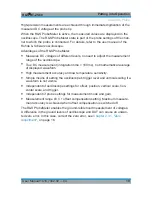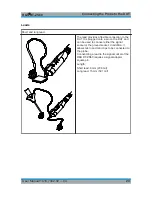
Measurement Principles
R&S
®
RT-ZS60
25
User Manual 1418.7342.02 ─ 04
4
Measurement Principles
The R&S
RT-ZS60 active voltage probe provides an electrical connection
between the DUT and the oscilloscope. The probe transfers the voltage of the
electrical signal tapped off the DUT to the oscilloscope, where it is displayed
graphically. Although a probe has a wide variety of specifications, these specifica-
tions can be grouped into two classes of basic requirements:
●
High signal integrity of the transferred signal:
With an ideal probe, the output signal that is transferred to the base unit is
identical to the input signal between the probe tips, and signal integrity is
extremely high. Every real probe, however, transfers the input signal in altered
form. A good probe causes only minimum alterations.
How the probe can fulfill this requirement is mainly determined by its band-
width.
●
Low loading of the input signal:
Every probe is a load for the signal to be measured. The signal to be mea-
sured changes when the probe is connected. A good probe causes only a
minimum change to the signal, so that the function of the DUT is not adversely
affected.
How the probe can fulfill this requirement is mainly determined by its input
impedance.
The parameters of a probe are usually specified for a minimally short connection
between the probe and the DUT. With longer connections, the connection induc-
tance has a significant effect on the measurement.
The high-frequency behavior of active probes is typically characterized in a 50
Ω
measurement environment. The probe is connected to a 50
Ω line that is fed by a
source with 50
Ω internal impedance and that is terminated into 50
Ω.
The
Figure 4-1
shows the equivalent circuit model of a probe that is connected to
the DUT.
















































